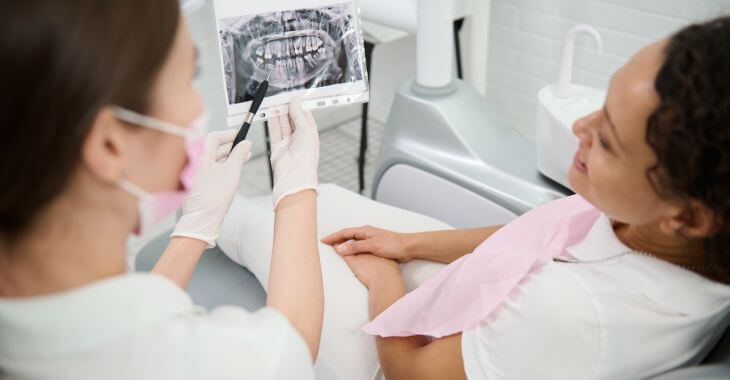What Is the Treatment for a Dead Tooth?

Teeth are alive when the interior pulp is connected to the blood supply and nervous system within the body. A dead tooth is when the pulp inside is no longer viable, usually due to an injury or disease that cuts off the blood supply. How do you know if you have a dead tooth and what are the treatment options?
Signs of a Dead Tooth
You may not know you have a dead tooth until you visit a dentist. Many times, the non-viable tooth does not look or feel any differently. Trauma or tooth decay are usually the cause of cutting off the blood supply, allowing the tooth to “die.” Some people will have symptoms, which can include:
- Pain. While some people have no pain with a dead tooth, others can experience minimal to excruciating pain. If the tooth becomes infected or abscessed, it is usually accompanied by pain.
- Odor. There can be a dead tooth smell that is unpleasant. You may have bad breath and mouth odor that does not go away after brushing your teeth or using mouthwash.
- Taste. If the dead tooth is infected, you may have a foul taste in your mouth due to the bacteria and pus inside the tooth.
- Color. Some dead teeth may darken or change color. This occurs when the blood supply is blocked and the pulp and nerves are deteriorating, releasing pigmented material into the white dentin of the tooth.
- Swelling. If the tooth is abscessed or infected, there may be a lump or swelling around the tooth. This can be due to inflammation or pus in and around the tooth, which can spread to other teeth or oral areas if not treated.
If you are experiencing a dead tooth smell, taste or pain, you should visit your dentist to discuss your options for relief. Dead teeth require treatment to prevent infection from spreading to the jawbone and other areas of the body. The recommended treatment is usually root canal for a dead tooth.
Root Canal for a Dead Tooth
Why do you need a root canal for a dead tooth? While it may be “dead,” it is also a breeding ground for bacteria. The pulp inside the tooth can be infected and the bacteria can spread to the bone and tissue around the tooth. The only way to stop tooth infection and save the tooth is with a root canal.
During a root canal, the tooth is opened up and pulp and nerve roots inside the tooth are removed. The interior of the tooth is disinfected to kill the bacteria, then repacked with a sterilized, rubberish material. The tooth is sealed, and most dead teeth will need a dental crown placed to protect it from damage.
If a root canal is not performed, the only other option is to pull or extract the dead tooth. It poses too large of a risk to your health to allow it to invite infection into your oral cavity. A root canal for a dead tooth is the best treatment option for eliminating pain and dead tooth smell while saving the tooth.
Dead Tooth Root Canal Before and After
If you have a dead tooth, it may be painful and leave a bad taste or odor in your mouth before your root canal treatment. You may also have a dark or discolored tooth that is not attractive if it is visible when you smile or talk. Once your have your root canal performed, it can protect your smile’s health and appearance.
Root canal therapy is usually performed with local anesthesia to numb the tooth. The treatment is no more painful than having a cavity filled, as the tooth is completely numb during the procedure. There may be some slight discomfort in the surrounding tissues after the anesthesia wears off, but only temporarily.
After your root canal for a dead tooth, the bacteria and dead tooth material are gone. This removes the unpleasant taste and dead tooth smell from your mouth. If you have a white crown placed over your discolored or darkened tooth, it will look more attractive and improve the appearance of your smile.

The good news is that even a “dead” tooth is still functional. It can still provide stability to your other teeth and stimulate bone growth in the jaw. It can also still chew food and perform other functions. Whenever possible, it is desirable to save a tooth, even one that is dead, versus removing it.
If you have signs of a dead tooth, you should schedule a dentist appointment. Dead teeth can put your oral and overall health at risk. Root canal therapy is the recommended treatment for dead teeth, removing potential for infection and other complications that can come with a deteriorating tooth.
The information provided on this website, including text, graphics, images, and other materials, is intended solely for informational purposes and should not be used as a substitute for professional medical advice, diagnosis, or treatment.




)